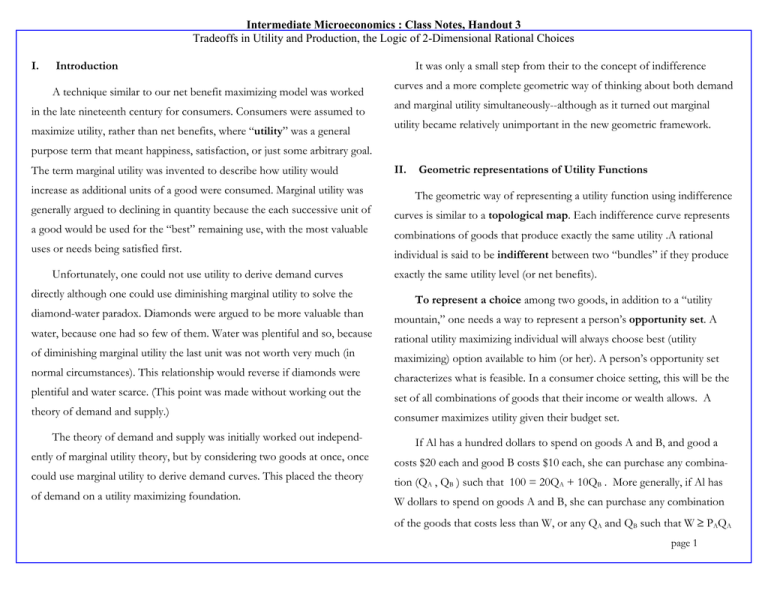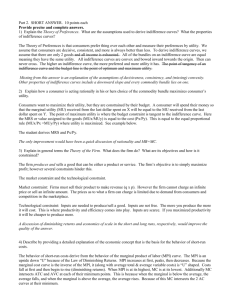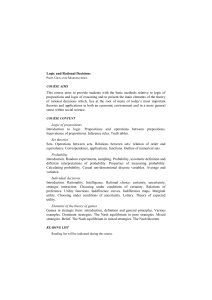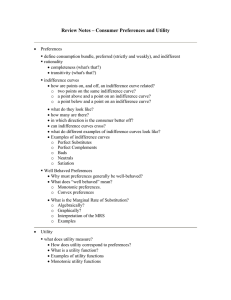Intermediate Microeconomics : Class Notes, Handout 3 I. Introduction
advertisement

Intermediate Microeconomics : Class Notes, Handout 3 Tradeoffs in Utility and Production, the Logic of 2-Dimensional Rational Choices I. Introduction A technique similar to our net benefit maximizing model was worked in the late nineteenth century for consumers. Consumers were assumed to maximize utility, rather than net benefits, where “utility” was a general It was only a small step from their to the concept of indifference curves and a more complete geometric way of thinking about both demand and marginal utility simultaneously--although as it turned out marginal utility became relatively unimportant in the new geometric framework. purpose term that meant happiness, satisfaction, or just some arbitrary goal. The term marginal utility was invented to describe how utility would increase as additional units of a good were consumed. Marginal utility was II. Geometric representations of Utility Functions The geometric way of representing a utility function using indifference generally argued to declining in quantity because the each successive unit of curves is similar to a topological map. Each indifference curve represents a good would be used for the “best” remaining use, with the most valuable combinations of goods that produce exactly the same utility .A rational uses or needs being satisfied first. individual is said to be indifferent between two “bundles” if they produce Unfortunately, one could not use utility to derive demand curves directly although one could use diminishing marginal utility to solve the exactly the same utility level (or net benefits). To represent a choice among two goods, in addition to a “utility diamond-water paradox. Diamonds were argued to be more valuable than mountain,” one needs a way to represent a person’s opportunity set. A water, because one had so few of them. Water was plentiful and so, because rational utility maximizing individual will always choose best (utility of diminishing marginal utility the last unit was not worth very much (in maximizing) option available to him (or her). A person’s opportunity set normal circumstances). This relationship would reverse if diamonds were characterizes what is feasible. In a consumer choice setting, this will be the plentiful and water scarce. (This point was made without working out the set of all combinations of goods that their income or wealth allows. A theory of demand and supply.) consumer maximizes utility given their budget set. The theory of demand and supply was initially worked out independ- If Al has a hundred dollars to spend on goods A and B, and good a ently of marginal utility theory, but by considering two goods at once, once costs $20 each and good B costs $10 each, she can purchase any combina- could use marginal utility to derive demand curves. This placed the theory tion (QA , QB ) such that 100 = 20QA + 10QB . More generally, if Al has of demand on a utility maximizing foundation. W dollars to spend on goods A and B, she can purchase any combination of the goods that costs less than W, or any QA and QB such that W PAQA page 1 Intermediate Microeconomics : Class Notes, Handout 3 Tradeoffs in Utility and Production, the Logic of 2-Dimensional Rational Choices + PBQB. This algebraic way of representing a what AL can buy is called her budget constraint. A 2-god budget set, budget constraint, or budget line can be illustrated with a diagram, as done below in figure 1. B. In figure 1, three indifference curves are drawn, but in reality there are an infinite series of these curves. Three is just a sufficient number to give one the sense of what Al’s utility mountain looks like. Evidently “more is better” over the range of interest, because more of either or both goods always produces more utility (puts her on a higher indifference curve). III. Optimizing given Budget and other Constraints A. We now have the basic ideas (concepts) necessary to develop another representation of the rational choices by consumers. w We can represent a persons goals using indifference curves (or a utility function). w We can represent their opportunities in market settings (with posted prices) using a budget constraint. Figure 1 Good A W/PA More Utility QA * Indifference Curves w A rational consumer will choice the combination of goods that maximizes his or her utility, which is the combination that places him or her on their highest feasible indifference curve. w In the case usually drawn, this will be a place where an indifference curve is tangent to the individual’s budget constraint (budget line). w [However, remember that the tangency condition is just a rule of thumb. What is always chosen by a rational consumer is the possibility that maximize utility given his or her opportunity set.] Budget Constraint QB * W/PB Good B C. Notice that the outer edge of the budget set (the opportunity set for this diagram) is a straight line that goes from W/PA to W/PB. w These two extreme points have an intuitive meaning. w If Al spent all of her money on good A, she could by W/PA units. If Al spent all of her money on B, she could buy W/PB units.. page 2 Intermediate Microeconomics : Class Notes, Handout 3 Tradeoffs in Utility and Production, the Logic of 2-Dimensional Rational Choices w Of course, Al can purchase any quantity inside the triangle formed by the line and the good A and good B axes, but since A and B are evidently both goods (more is better), the inside of the budget set is not important. w Although the geometric logic of maximizing utility subject to a budget constraint differs from that of the net benefit maximizing model, it is really fundamentally similar. w That the budget constraint is a straight line is implied by the equation, W = PA QA + PB QB. w In both cases, rational individuals are assumed to maximize something (net benefits or utility) that is only partly under their control, because they face costs or constraints. w The slope of the budget line turns out to be -PB/PA in the diagram if “A” is interpreted as the “Y” axis. w (So if you understand the logic of the NB maximizing model, it should be relatively easy to master this new model.) D. The highest indifference curve that can be reached given this budget line is the one that is tangent to the budget line (just touches it). It is the combination labeled QA*, QB*. E. This model of the rational consumer allows us to characterize the choice over various combination of goods, given any opportunity set. w This allows us to get a more complete picture of how individuals adjust to changes in prices and income--and any other factors that may change their opportunity sets. w It also allows us to analyze a broad range of choice settings, types of individuals, and changes in circumstances. G. The basic consumer model can be extended to take account of different kinds of persons (e.g. persons with different tastes) and/or to persons who face different constraints. w Figure 2 shows a person with “odd” preferences w This person has a utility function with a “bliss point,” a top, just as ordinary mountains do. w More is not always better for this person. w Such a person will often, but not always be influenced by changes in their wealth or prices. [Illustrate and/or explain why.] w All we need are indifference curves and opportunity sets. F. Because you can analyze settings that are more complex than possible using the net benefit approach, the “constrained optimization” model of rationality is the dominant one in Economics, Game Theory, and Rational Choice Political Science. w This does not, however, mean that the net benefit maximizing model with its assorted area tools is never used. w In fact, in most upper level “applied micro” courses, they are used more frequently than the Utility maximizing model. page 3 Intermediate Microeconomics : Class Notes, Handout 3 Tradeoffs in Utility and Production, the Logic of 2-Dimensional Rational Choices w (ii) finds the implied budget constraint, Figure 2 w (iii) determines the combination of goods purchased, Good A w (iv) and plots the price and quantity on a separate diagram. Top of Utility Mountain W/PA w (v) This process is repeated to trace out the entire demand curve. w QA* w This process is illustrated in Figure 3 for three prices. Indifference Curves Budget Constraint QB* W/PB Good B IV. Deriving a Demand Curve using Indifference Curves and a Series of Budget Constraints w Note that when ever a price changes the budget constraint changes. w Note also that as prices fall for the goods along the horizontal axis the budget constraints become flatter. w Nonetheless, the highest indifference curve that can be reached is always (in the normal case) a place where an indifference curve is tangent to the budget line.. A. The meaning and logic of demand curves are not changed when we shift from the net-benefit to the utility maximizing representation of rational choice. w In both cases, a demand curve tells us how much of a particular good a person will purchase at various prices. And, the basic steps that one takes to derive a demand curve do not really change, although the geometry does. w (i) One chooses a price, page 4 Intermediate Microeconomics : Class Notes, Handout 3 Tradeoffs in Utility and Production, the Logic of 2-Dimensional Rational Choices w [As an exercise, draw an odd set of indifference curves and derive a demand curve from them.] Figure 3 Good A Maximizing Utility with 3 different Prices for Good B W/PA V. More Utility Q’’’AQ’’A Q’A Indifference Curves Budget Constraint with lowest of these three prices Q’B Q’’B Q’’’B W/P’’B W/P’’’B Good B Price of Good B W/P’B Three Points on Al’s Demand Curve for Good B P’B P’B’ Income and Substitution Effects A. In the net-benefit maximizing framework, we were able to show that demand curves always slope downward. That is to say, all the points on an individual’s MB curve that make their way to his or her demand curve were from the downward sloping parts of the MB curve. B. This is usually the case for demand curves derived from the utility maximizing model, but not always. w To make sense of this surprising result, economists distinguished between income and substitution effects. w When indifference curves slope downwards and are C-shaped, the substitution effect of an increase in prices is always negative. One always tend to reduce purchases of the good with the new higher price and substitute the other good for it. P’’’B Q’B Q’’B Q’’’B Quantity of Good B w Note that the quantity of A is also normally affected by changes in price of B. It rises and falls. w This helps explain why the demand for a good is affected by the prices of other goods: substitutes and complements. w However, real income falls because the budget set shrinks. The implied “income effect” may be negative or positive according to whether the good is a “normal or superior” good or a “inferior” good. w Inferior goods are goods that one purchase more of when one has less money, wealth, or income. As prices rise, one become poorer (one’s opportunity set shrinks) and so one will purchase more inferior goods. w Inferior goods thus have positive income effects that partly or entirely offset the substitution effect of a price increase. page 5 Intermediate Microeconomics : Class Notes, Handout 3 Tradeoffs in Utility and Production, the Logic of 2-Dimensional Rational Choices w A Giffen good is an extremely inferior good. Its income effect is so strong that it overwhelms the substitution effect and generates an upward sloping demand curve--at least in theory. w [It is often claimed that no Giffen goods have ever been found. If so, what is the point of working so hard to characterize income and substitution effects?] Figure 4 Good A W/PA More Utility C. Geometry of Income and Substitution Effects. w Draw a standard budget constraint with an indifference curve tangent to that budget constraint. w Raise the price of one of the goods. (I will raise the price of the good on the horizontal axis, but either will work.) w Note that the higher price changes the slope of the budget line and implies a new utility maximizing combination of goods. w Draw in an imaginary budget line parallel to the new budget line, but tangent to the original indifference curve (the one that was tangent to the first budget line). w Note the new optimal bundle implied. w The substitution effect is the change in the quantity of the good whose price has increased from the original bundle to the imaginary one on the red dotted line. w The income effect is the change from that quantity to the one on the actual budget line chosen after the price increase. QA 2 QA 1 income effect Qb 2 Q’ Q 1 B 2 W/PB 1 W/PB Good B substitution effect D. One can also use indifference curves and budget constraints to represent how patterns of consumption will change when wealth or income changes, by changing W rather than a price. w The result is an income-consumption path w Which can be used to derive an Engels curve, which describes how income affects purchases of a particular good. w [This will be done in class, but try to do so as an exercise before class.] page 6 Intermediate Microeconomics : Class Notes, Handout 3 Tradeoffs in Utility and Production, the Logic of 2-Dimensional Rational Choices VI. The Edgeworth Box: Equilibrium in a Barter Economy A. One of the extremely clever things that one can do with indifference curves and budget constraints was worked out by an economist named Edgeworth in the late nineteenth century. w The collection of all such points is called the contract curve, because if trades do take place, trading will stop once such a point is reached--e.g. a final contract is made. Figure 5: Trading Goods X and Y w Edgeworth found that by drawing two indifference curve diagrams and combining them, he could illustrate (i) why gains to trade exist and (ii) what a “general equilibrium” price looked like in a barter economy (an economy where goods are directly traded for one another). ZB 2 w Edgeworth’s diagram shows that for most points in the box, there are unrealized gains to trade. 3 potential gains to trade B. Trade can make both persons better off from most but not all places in the Edgeworth box. w The region in which gains to trade exist can be found by drawing an indifference curve for each person through a point in the box (normally the “original endowment”). w The football shaped area between the indifference curves is the region in which gains to trade exist. w Any move from the point of interest (such as the one’s labelled 2 or 1). Such mutual gains exist for most of the points in the box. w w The points where no gains to trade exist are those where one person’s indifference curves are tangent to the others. [Explain why.] Bob 1 Al ZA C. Pareto norms and the Edgeworth Box w The area of mutual gains to trade was later called a Pareto set. w It is composed of all distributions of the goods (points in the Edgeworth box) that make each person simultaneously better off. w State of the world 3 is said to be Pareto Superior to state 1, if and only if at least one person prefers 3 to 1 and no one prefers 1 to 3. page 7 Intermediate Microeconomics : Class Notes, Handout 3 Tradeoffs in Utility and Production, the Logic of 2-Dimensional Rational Choices w State of the world 3 is said to be Pareto Optimal if and only if there are no (feasible) Pareto Superior Moves at 3. w The contract curve is the set of Pareto Optimal states in an Edgeworth Box. w (As an exercise, demonstrate that position 2 is not Pareto superior to position 1.) VII. Production Functions A. A similar geometry can be used to understand a firms choice of production methods. w The net benefit maximizing framework explains the output decisions of firms quite well, but it does not shed much light on how a firm will produce its outputs. w We know from that approach that a rational firm will minimize the total cost of each unit of output produced, because that is necessary if profits are to be maximized. w It turns out that one use this idea to develop geometric tools for understanding how a firm adjusts its input mix as it expands production. B. Inputs and Outputs w Output is the aim of production. It is what one plans to sell. w Inputs are all the labor, machines, and materials used to produce the output. C. Isoquant and Isocost lines w Isoquant curves represent all combination of inputs that can be used to produce a particular level of output (without waste). They generally are assumed to be C-shaped, although other shapes are possible w Isocost curves represent all combinations of inputs that can be purchased for a given amount of money (all combinations that in total cost the same). w These curves have the same general shape as budget lines (in competitive markets), whenever inputs are purchased in competitive markets (e.g. at given prices). [Explain why.] VIII. Choosing the Best Way to Produce A. Production Expansion Paths w The firms will want to maximize the output that can be produced for a given cost or equivalently to minimize the cost of each output level. w The combination of inputs that minimizes the cost of a given output and which maximize output for a given cost occur at input combinations where an isocost line is tangent to an isoquant curve. w [Draw and example, and note the tangency solution.] B. Output Expansion Paths and Total Cost Functions w The output expansion path is the series of input combinations that a firm will adopt as it increases output. w These occur at the tangencies of the isocost and isoquant curves. page 8 Intermediate Microeconomics : Class Notes, Handout 3 Tradeoffs in Utility and Production, the Logic of 2-Dimensional Rational Choices w This series of tangencies also describes the firm’s total cost function, the minimum cost of every level of output. w And, of course, one you know a firm’s total cost function you can determine its marginal cost function and thereby its supply curve using the method worked out earlier in the course. Marginal cost is the change in total cost for a one unit change in output, it is the slope of the total cost curve. w (A good deal of the material in this lecture is in some ways easier to do with calculus, but you are expected to know this geometry after an intermediate micro course.) C. Effects of changes in Input Prices w In addition to providing a richer foundation for cost curves, isocost and isoquant based analysis can also be used to show how changes in input prices will affect a firm’s best method of producing its output(s). w A change in the price of either (or both) output changes the slope of the entire series of isocost lines, which makes new combinations of inputs the best to use. w The new series of isocost lines will imply a new series of tangencies and so a new production expansion path. w [Draw an output expansion path illustration with three isocost lines, then draw in three new isocost lines with new slopes (because of input price changes) and see how the production expansion path is affected.] w Note that this method also gives one a sense of how a firm’s demand for inputs is affected by input prices. w Thus, in general, the demand for inputs is downward sloping. D. The technology of production has been assumed constant in the above diagrams. w However, technological change can also be modeled in isocost-isoquant diagrams. w Technological shifts changes in the shapes of a firm’s isoquants. w In the net benefit framework, a technological improvement can be represented as an increase in the marginal product of at least one input. E. Production possibility frontiers w We can use similar geometry to analyze a person’s production for his or herself. w Given a finite set of inputs, one can, in principle, plot all the possible combinations of outputs that can be produced. w This “constraint” over alternative outputs is partly caused by the stock of inputs and partly by technology. It is called the production possibility frontier. w Production possibility frontiers can be used to think about personal choices, firm choices, and national choices. F. For example, Crusoe’s problem on the island was deciding what to produce given his labor, his knowledge of production techniques, and the resources of “his” island. w His resources implied a multidimensional production possibility frontier. w Firms will substitute away from the input with a higher price. page 9 Intermediate Microeconomics : Class Notes, Handout 3 Tradeoffs in Utility and Production, the Logic of 2-Dimensional Rational Choices w However, if you consider just two possible outputs (say food and shelter), you can use a production possibility frontier in combination with Crusoe’s indifference curves to represent his production decision. w [Draw a production possibility frontier and series of indifference curves and show the utility maximizing combination of outputs.] w [Compare these with their counterparts from the previous handout.] w [Note that both sets of diagrams have similar implications, but the ones based on this handout (3) are a bit more detailed.] IX. The geometry of market equilibrium with indifference curves and isoquants w Notice, that you can now use a broad range of tools to represent a market equilibrium, with several possible diagrams to represent the effects of market prices on individual consumers and firms and also on input markets. w Again both net-benefit and utility-maximizing representations of consumers and firms are possible. w In general, both sets of tools show how prices affect decisions throughout markets. w Prices thereby coordinate the choices (and behavior) of a huge number of consumers and firms in a huge number of markets. w In contemporary world markets, prices affect the decisions of thousands of firms and millions of input providers and consumers. w [Draw demand and supply curves, and individual consumer and firm curves based on the two dimensional models of this handout.] page 10




